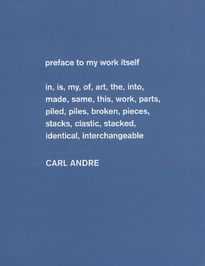
Hard Cover, Thread Stitching, 2014 Pages, 2014, Dia Art Foundation
Carl Andre – Sculpture as Place
availability unknown, if interested please write an email
Die Bedeutung des Ausnahmekünstlers Carl Andre zeigt sich in dieser umfassenden Publikation auf das Eindrücklichste. Die über 300 Objekte umfassende Retrospektive untersucht erstmalig das gesamte Oeuvre dieses wegweisenden Bildhauers des 20. Jahrhunderts und eröffnet somit die seltene Möglichkeit der gründlichen Rezeption seines vielfältigen Werks.
Neben einer präzisen Auswahl an raumgreifenden Bodenskulpturen zeigt die Publikation auch Werke aus der frühen, aus einfachen Holzbalken geschaffenen "Element Series" oder die aus 137 Ziegelsteinen bestehende Arbeit "Lever", mit der Carl Andre 1966 seinen Durchbruch feierte. Eine breite Auswahl bislang unveröffentlichter "!Conrete Poems", Briefen, Postkarten und Ephemera vervollständigen den Band.
Carl Andre (b. 1935) redefined the parameters of abstract sculpture in the 1960s and 1970s. He was a highly influential voice in the American minimalist movement, recognized for his ordered linear and grid formats.
In the early 1960s, Andre’s creative focus shifted to writing poetry when he took a job as a freight brakeman and conductor for the Pennsylvania Railroad. His poems echoed and extended the themes in his sculptural work, and his experience with the railroad significantly influenced his choice of materials in later years.
In this stunning catalogue, which accompanies the first retrospective of Andre’s work since 1970, the artist’s legacy is examined in eleven essays by international scholars. The book presents a broad range of sculpture made over the past fifty years, including Andre’s emblematic floor and corner pieces, highlighting his radical use of standardized units of industrial material such as timber planks, concrete blocks, and metal plates.
A vast selection of Andre’s previously unpublished concrete poems, together with letters, postcards, ephemera, and documentation of important installations, further complements our understanding of an essential figure in the history of contemporary art.
